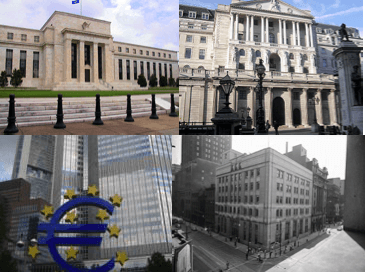 Over the past five years major central banks around the world from the Bank of Japan through the Bank of England to the Federal Reserve in the US have enforced an easy money policy. Interest rates were slashed to between 0.00% and 0.50% and currencies devalued in what many started to refer to as currency wars. The tightening cycle saw central banks increase their balance sheets and print money at a record pace, especially in the US.
Over the past five years major central banks around the world from the Bank of Japan through the Bank of England to the Federal Reserve in the US have enforced an easy money policy. Interest rates were slashed to between 0.00% and 0.50% and currencies devalued in what many started to refer to as currency wars. The tightening cycle saw central banks increase their balance sheets and print money at a record pace, especially in the US.
The US Dollar is the most oversupplied currency in the world and the pace at which the Federal Reserve has printed new US Dollars, which started under Ben Bernanke and will resume under Janet Yellen, which according to supply and demand makes the US Dollar worth less against all major currencies. This is partially reflected by the fact that for example €1 is equal to $1.1775 or that £1 is equal 1.5000, but despite the oversupply of US Dollars this currency has witnessed a sharp rally over the past seven months.
This is due to the hope that the Federal Reserve will increase interest rates by September of this year. The exit of its third monetary stimulus has also assisted the rally in the US Dollar. One final reason for the recent strength in the US currency is hope that during a global crisis the US Dollar will remain safe. Economic data out of the US has pointed towards a much slower economy than expected, so is hope for an increase in interest rates all that keeps the bullish momentum alive?
The US Federal Reserve may not act at all and forex traders can see a prime example of what happens to a currency which was boosted by hope for central bank action which was delayed if they take a look at the British Pound. The British Pound rallied strongly in 2014 driven by better than expected economic data in the first half of the year and by hopes for an increase in interest rates by the Bank of England under Governor Carney. The Bank of England delayed an interest rate increase and the British Pound went into freefall.
The Bank of New Zealand announced late last year that it intends to increase interest rates which makes the New Zealand Dollar the most attractive currency for the first-quarter of 2015. The New Zealand central bank will most likely increase interest rates by 25 basis points by March which should give the New Zealand Dollar a strong boost. The Bank of England may delay it into the end of 2015 while the US Federal Reserve may not raise rates at all this year. This would cause a massive sell-off in the US Dollar.







